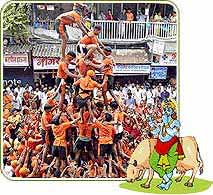Janmashtami Celebrations
Celebrated to mark the birth of Lord Sri Krishna, the festival of Janmashtami is a popular event in India and many other countries across the world. Devotees of Lord Krishna solemnise the festival with lot of joy and enthusiasm. All efforts are made to give the festival an extremely decorative look.
 Festivity for over Two Days
Festivity for over Two DaysJanmashtami festivities continue for two days and reach its peak at midnight of the first day. This is the time when Lord Krishna is said to have been born. The blessed event marking Bhagwan Krishnas birth is celebrated with zeal in different states of India. Mathura, the birthplace of Lord is particulary famous for its grand celebrations. Janmashtami is also celebrated with verve in the states of Maharashtra, Gujarat and Tamil Nadu.
Celebrated with Splendour
Sri Krishnashtami is celebrated with lot of pomp and show. During the midnight celebration, lord's idol is bathed with Panchamrit and then the cradle is rocked. Devotees fast all day long and break it after the birth of Bhagwan Krishna at midnight. Songs and hymns are sung by people accompanied by dancing in praise of their favourite 'Makhan Chor'. Aarti is performed by blowing conch and ringing of bells. Elaborate Pooja (Prayer) and ceremonies are held in the honour of Bhagwan. Prasad is distributed among devotees after the birth ceremony.
Environment of Euphoria and Glee
Janmashtami creates an environment of happiness and joy among the devotees. With loads of ongoing fun activities, people are lost in the joy of divine songs and dances performed in praise of Lord. Colorful Rasleela (plays) are performed by devotees depicting significant phases and acts of Lord's life.
Janmashtami Special Dishes
As Lord Krishna was very fond of sweets, milk and other milk products like butter and buttermilk, so his devotees make sweets of these products to commemorate the occasion. Sweets like Doodhachi Kheer, Pedha, Gopalkala or Gulabjamun are the major dishes prepared on Krishnashtami. Besides, Shrikhand and Singhare ki Poori are also made in households. Eatables like Murukku and Seeddai are popular in the Southern State of Tamil Nadu.
Jhulanotsava and Ghata Celebrations
A common feature of Janmashtami in North India, especially Mathura is 'Jhulanotsava'. In this, Jhulas (swings) are hung in the courtyards of temples and houses in honour of the Lord. Another distinguishing feature of Janmashtami festival celebrations is 'Ghatas'. This is a month long programme wherein a particular colour is selected as a theme and the entire temple is adorned with the same colour. The idol of God is also adorned with clothes of the same colour.
Dahi Handi, Raslila, Jhankis
Celebration of Sri Krishna's birth will be incomplete without Raslila (Dance Drama). In this extremely popular and joyful drama, incidents from Sri Krishna's life are enacted in form of dance. In a good performance devotees are virtually transformed into the time and age of Lord Krishna. The experience is absolutely mesmerizing.
The ritual of Dahi Handi is carried out with much fanfare and joy. Human pyramid is formed to break the Handi (Earthen Pot) suspended from top with the help of a rope. The exciting process involves throwing water by the onlookers to prevent the boys from breaking the earthen pot. Dahi Handi ritual is most popularly celebrated in Mumbai.
Jhankis (tableaux) are cribs and other decorations depicting the entire life of Lord Krishna right from the time of his birth. Various jhankis include bith of Lord Krishna in jail, Vasudev,father of Lord Krishna taking out of the jail to his friend Nand, River Yamuna in floods finally bowing to the feet of Lord and making way,Exchange of Lord with the baby girl etc.
Janmashtami is celebrated with fervor all over India and with the spread of Hinduism,it is celebrated with similar emotion all across the globe.
Janmashtami Special